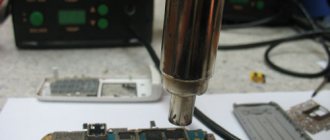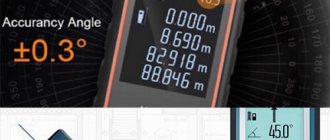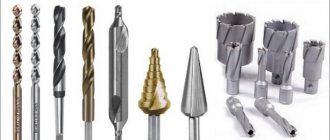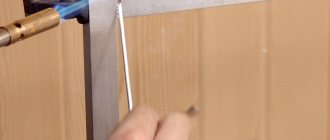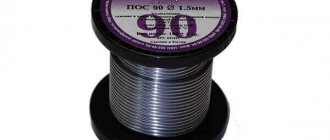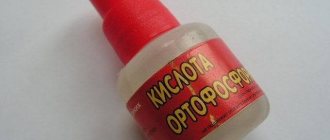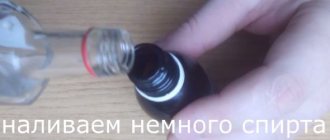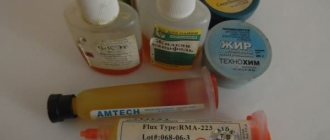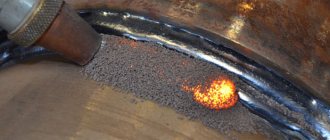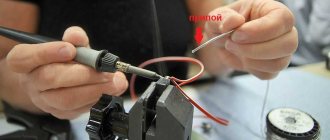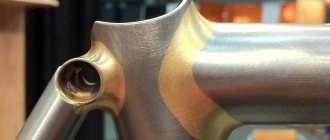Features of application and soldering with soldering acid
The category into which soldering acid falls differs from other reagents and has a number of positive properties. As a flux, the product is distributed only in liquid form; some compositions can be diluted to reduce the concentration when interacting with metal. Before using the element, it is worth understanding what soldering acid is needed for.
Before soldering metals, it is necessary to prepare the areas for use. With prolonged use, metals tend to oxidize, and a layer of dirt and dust forms on them. If it is possible to deal with dirt mechanically, using sandpaper or a file, then oxides can only be removed using chemical solutions. Soldering acid helps prevent the formation of a new film and remove existing deposits.
Cleaning metal with soldering acid
Basic metals that can be treated with soldering acid:
- copper alloys of any proportions;
- iron products;
- nickel;
- all kinds of non-ferrous metal alloys;
- steel.
Brass and copper alloys can be soldered using borax. Aluminum or steel products will not be connected in any way without soldering acid. Before soldering with acid, the part is treated to remove solid deposits, and after soldering it is washed off with water with a low alkaline content. Varieties of soldering products are produced according to GOST 23178-78 standards, they have fluidity and low viscosity.
Fluxes made from aspirin and salicylic acid
One of the craftsmen, not finding rosin or other flux in the house, thought of using ordinary aspirin to treat the elements before soldering. Acetylsalicylic acid tablets can be used to repair household appliances. True, when aspirin is heated, caustic vapors are formed, so you should work with acetylsalicylic flux in a ventilated area. One way to tinning is to sprinkle aspirin powder on the part. In another way, the wires are placed on a whole tablet and heated with a soldering iron.
VTS flux is produced based on salicylic acid, which is often used in electrical installations. This composition provides protection to welded parts from corrosion, so it is preferred when carrying out this type of operation. HTS is used for processing copper and its alloys, as well as elements made of precious metals. The flux contains:
- solution of salicylic acid and ethanol (C2H5OH) - 6.3%;
- triethanolamine - 6.3%;
- technical petroleum jelly - 63%.
Types of soldering acids and application features
Soldering acid is divided into two main types, regardless of the scope of application, orthophosphoric and hydrochloric type. Regardless of the composition, the purpose is to remove oxides and contaminants from soldering areas. A high-quality, neat seam can only be made if the metal preparation conditions are met. The durability of materials is increased due to the formation of a protective film against oxidation on the joint surface.
It is important to know that using flux when working with electronic boards is strictly prohibited. Thin and fragile elements can be erased from the board structure; soldering acid produces conductive connections. All these factors can have a detrimental effect on the performance of the unit and the overall condition of the structure.
Zinc chloride flux
A solution of zinc chloride is used for soldering iron compounds. The composition is zinc dissolved in hydrochloric acid. The solution is made as follows:
- granular zinc is prepared;
- depending on the technical specifications, add a solution or concentrate;
- After the chemical reaction of zinc, it is possible to use a mixture.
Zinc chloride
Proportional parts are taken using the example of 1 liter of saline solution per 400 grams of granulated zinc. At the end of the work, the surface should be treated to stop the reaction; a soap solution is excellent for this. Before making it yourself, you should remember that it is important to follow the sequence. The acid is diluted with zinc, and gases are formed, resulting in a rather explosive mixture. All actions are carried out in a ventilated place.
Oleic acid
Olein is excellent for soldering aluminum alloys. Not used in its pure form, available only in technical condition. A stable state is achieved by mixing olein with various fatty acids. Next, lithium iodide reacts, which completes the mixing of the aluminum soldering mass.
Soldering with oleic acid allows you to join materials from copper and aluminum alloys, without the formation of a chemical film and oxidation.
Oleic acid B-115
Flux is used to protect against corrosion processes at the joint; under mechanical stress, a new film is formed, which allows you to not worry about the reliability of the connection.
Instead of soldering acid, other fluxes do not have similar properties; it is possible to use machine oil with ground sawdust; the soldering process involves rubbing in the composition during joining. When heated, the oleic type of soldering acid evaporates, but the soldering area is tinned, so there is no point in worrying about the quality of the connection.
Orthophosphoric acid
When treating metals with an orthophosphorus solution, a protective film is built that prevents the formation of oxides and chemical reactions of the metal. The characteristics of the solution consist of a colorless substance, inorganic. The hygroscopic structure in the form of a paste structure reacts when heated and dissolves into a liquid composition. It has good flow properties and is easy to clean with water after use.
Soldering with phosphoric acid
Phosphoric acid is used for soldering carbon and alloy steels. Copper and nickel alloys are also suitable for work; the operating temperature for soldering starts at 350 degrees. The acid film is loosened and removed to the surface by dissolving the oxide layer. Reliable soldering is achieved by forming an oxide film with orthophosphoric acid.
Flux VTS
Salicylic base, common in aspirin, is used as a component of soldering flux. It is most widely used when working with precious metals, due to its weak interaction with the particles of the product.
The main advantage is protection from oxidation of the soldering area; there is no need to remove flux, unless additional requirements are imposed.
VTS flux paste
The versatility of application and low-cost manufacturing allow the use of soldering acid based on salicylic compounds. Caustic emissions require a working hood when performing soldering operations, and the negative side is poor interaction with aluminum.
It is possible to use improvised means, just grind an aspirin tablet or another drug containing salicylic acid. The powder is applied to the soldering area; when working with wires, soldering can be done directly on the tablet. A more convenient mixture is made together with Vaseline, proportions 1 to 2; the paste can be easily applied to the soldering area with a tampon and removed when the work is completed.
The need to use acid fluxes
Any soldering acid - hydrochloric or phosphoric acid - is designed to create an ideal environment for the interaction of solder with elements.
Their use makes it possible to remove contaminants and oxides from the working area, prevent the resumption of the oxidation process and reduce the tension of the solder, in order for it to spread more freely.
As a result, reliable soldering of parts is ensured.
Depending on the type of metal, the flux for soldering is selected. It is worth noting here that soldering acid is not used when assembling boards.
Acid belongs to the category of aggressive media and contributes to the destruction of components standing in its path.
In addition, it is an ideal electrical conductor and has the property of creating additional conductive channels.
Therefore, you should not even count on neutralizing the acidic environment after soldering.
Benefits of acid
Each composition has certain advantages, soldering accessories are no exception.
Soldering aluminum with acid
Main positive aspects:
- The convenience of the process, soldering allows you to process a contact in a hard-to-reach place due to its fluidity properties.
- Increased aggressiveness allows you to destroy oxide films and rust deposits. Typically, oxide films are not visible to the eye, so the connection must be processed.
- There is no need to worry about the subsequent formation of an oxide film; soldering acid counteracts this, even mechanical stress.
- The variety of metals with which it is possible to perform operations allows the solution to be used for every job.
How to solder without a soldering iron
There are cases when you can do without a soldering iron altogether. For example, to solder twists of wires during electrical installation work, it is enough to lower the twist into a container with acid, and then immerse it in heated solder and hold for about 1 minute. This soldering perfectly ensures electrical conductivity of the wires.
To subsequently avoid metal corrosion, flux residues should be removed. In addition, we must not forget that soldering of electronic devices is carried out without the use of soldering acid: it can damage very thin conductive traces of the boards.
Flaws
In addition to the positive aspects, there are also some disadvantages that can limit the use of the chemical element:
- It is strictly forbidden to use acids when working with radio circuits and small electronics. The properties of some compositions are such that the tracks are destroyed during the processing and growth of new conductive elements.
- The shelf life is underestimated due to the volatility of gases, so it will not be possible to purchase these fluxes with a reserve. There are also requirements for storage conditions, non-compliance with which can lead to damage to the material;
- The composition is harmful to humans if inhaled or in contact with skin. It is recommended to use personal protective equipment during mass work; soldering should be carried out in a well-ventilated area.
Phosphoric acid flux
Another common soldering acid is phosphoric acid (H3PO4). It successfully removes oxides from metal surfaces and protects them from the formation of new compounds with oxygen, which form a film on the metal that prevents parts from soldering. It is no coincidence that phosphoric acid is included in most products for anti-corrosion treatment of steel structures.
For soldering chromium and nickel alloys, acid is not used in its pure form. Almost 1/3 of the flux consists of ethyl alcohol. H3PO4 accounts for 32%, and rosin accounts for 6% of the composition. In other compositions for tinning and soldering, the volume of acid can reach almost 100%. Often, orthophosphoric acid is diluted together with zinc chloride, the mass content of which in the flux can range from 50% to thousandths of a percent. H3PO4 is used not only for joining parts made of nickel alloys, it is used for soldering products made of low-alloy steel and pure copper or its alloys.
Table of acid fluxes.
Orthophosphoric acid is part of the F-38 N active flux, which is used for soldering:
- alloy, low-carbon and medium-carbon steel;
- copper and its alloys;
- chromium-nickel alloys.
F-38 N is used for soldering in places with difficult access and protects the soldered parts from corrosion. It contains:
Phosphoric acid is explosion- and fireproof, but working with it and storing it must be carried out in compliance with all safety precautions. After contact with the skin or eyes, the substance should also be washed off with running water. The duration of washing is at least 10 minutes.
Composition and physicochemical properties
Orthophosphoric acid has the formula H3PO4, which consists of phosphorus itself and diethylamide. The proportions may vary from the required concentration, in most cases a ratio of 1 to 4 is used. There is a type of acid with zinc impurities in ratios of 1 to 2 parts of the solution.
Phosphoric acid formula
The basic properties of the material imply aggressiveness. Active interaction occurs with any material; this fact requires careful handling of compounds. During work, you must adhere to special rules, because... a positive or negative scenario may occur. The liquid form allows the composition to penetrate into hard-to-reach places and achieve high soldering strength. The main types of soldering acid are solutions, since a 100% concentration will not allow working with most metals.
Fluxes Amtech RMA-223 and Kingbo RMA-218
The third bronze place is occupied by Amtech RMA-223 - it is a gel flux - a mixture of crushed rosin and solvent.
I also suspect there may be activators and fragrance in the composition. – the most important sign of a fake is that on the sticker there is an inscription in small print “Coliformia” instead of “California”, however, strangely enough, the Chinese counterfeit flux is very good in operation, and many services rely only on it. Although the masters from mysku do not recommend using this flux, but it is better to take an analogue.
Advantages:
it’s convenient to apply the gel, good solderability, no need to wash it, the fake is cheap (about 200 rubles), but it solders quite well and smells of perfume.
Flaws:
often counterfeit, smokes due to the presence of rosin, the counterfeit must be washed off.
What to solder: contacts of microcircuits and SMD components, output radio elements.
What to wash off with: alcohol, solvent, the original does not need to be washed off, but the fake must be washed off.
Features of choice
The composition of soldering acid is selected in accordance with the working surface of the material. The main criterion should be the quality of the solution, because If the concentration is incorrect, you can always lower it at home. It is not permissible to use formulations with sediment or cloudiness in the container.
It is important to remember that liquid fluxes are one of the few soldering accessories that have an expiration date, which you need to pay attention to before use.
Difficult choices always haunt you when purchasing. The compositions are different, there are a large number of manufacturers on the market. It is necessary to determine what type of work will be performed; for this purpose, the purpose of the soldering acid composition is studied. Orthophosphorus compounds are the most common, they fight oxides well and are not so aggressive. Salt is more versatile, because... applies to a variety of metals. Sulfur is the most active option, used when soldering thick products.
Rating of the most popular soldering fluxes
1. Flux Kingbo RMA-218
| More details | |
2. Flux Amtech RMA-223
| More details | |
3. Rexant “BGA and SMD” flux gel
| More details |
DIY making
With some knowledge and available materials, it is possible to make soldering acid at home. The set of ingredients is not large; they can be purchased at a hardware store:
- hydrochloric acid in its pure form;
- lump zinc, which is sold by the chemical reagents department; if it is not possible to purchase, a finger-type battery is carefully opened;
- container made of glass or ceramic material.
Soldering acid is made by hand in a certain sequence. It is necessary to fill the container with pieces of zinc, then fill it with saline solution. The actions are carried out in a well-ventilated area; if the solution gets on the skin, you must immediately rinse with running water. After production, the mass is poured into an airtight container for proper storage.
Safety regulations
In the production of soldering acid, hydrochloric and phosphoric acids are used. They are very active (although phosphorus is weaker) and easily react with many chemicals. When such substances come into contact with the skin, they cause a chemical burn.
Read also: Three-phase electrical wiring diagram in a private house
Even when diluted, their vapors can damage the mucous membrane of the sensory organs.
Taking into account the above facts, safety rules when handling soldering acid include secure storage of the drug, the use of protective clothing and gloves, and good ventilation of the work area.
[Acid for soldering is necessary] if the use of rosin does not allow the necessary elements to be properly soldered together.
The use of soldering acid for soldering helps remove the oxide film layer from the surfaces being soldered and makes it possible to properly prepare them for joining.
As a rule, rosin is used to prepare copper parts for soldering with your own hands. But soldering acid is used for tinning not only copper, but also its alloys - bronze and brass.
And also for stainless steel, precious and ferrous metals, aluminum and nickel, even for soldering cast iron.
Precautionary measures
Aggressive properties require a special approach to safety precautions. Storage is carried out in original packaging, protected from direct sunlight.
It is better to carry out work with good ventilation, using the necessary protective equipment.
The skin reacts negatively to aggressive substances. If it gets on your hands, wash it immediately with water and laundry soap. Inhalation may cause oral irritation, and if it gets into the eyes, seek professional help.
Features of metal soldering
For a quality connection, it is important to follow certain instructions; the work differs from soldering with ordinary solder.
Soldering acid is used in many cases, before starting work it is important to follow the steps:
- Coarse dirt and metal oxidation are cleaned with sandpaper or a file.
- The flux is carefully applied using a brush or a special dispenser; the solution is in a liquid state, so it easily spreads over the surface.
- Tinning occurs with the application of solder, the products are fastened together.
After completing the process, it is necessary to remove the remaining solution. This can be done with ordinary soapy water or a solution of soda.
General rules of application
For soldering, tin-lead solder (PLS) is usually used. Its main component is always tin, and lead is added in proportions, depending on which the solder acquires the properties necessary for soldering.
Lead makes the material softer and more fluid, while tin provides strength to the hardened joint.
Despite the presence of lead, the fluidity is often not enough to overcome the surface tension forces in a drop of solder, and with little adhesion to the metal surface, the solder remains in the form of a drop that does not want to stick to the parts.
If the surfaces are first cleaned of oxides, the adhesion force will exceed the forces of surface tension and the solder will spread over the surface, ensuring good adhesion, that is, sticking.
To clean the surface, it is mechanically cleaned using a file or sandpaper and soldering acid is applied. It can be applied with a small brush made of natural materials or with a small spatula.
Often the composition is contained in plastic bottles with dispensers that are convenient to use. The flux must cover the entire surface to be soldered, otherwise the solder will not stick well to it.
